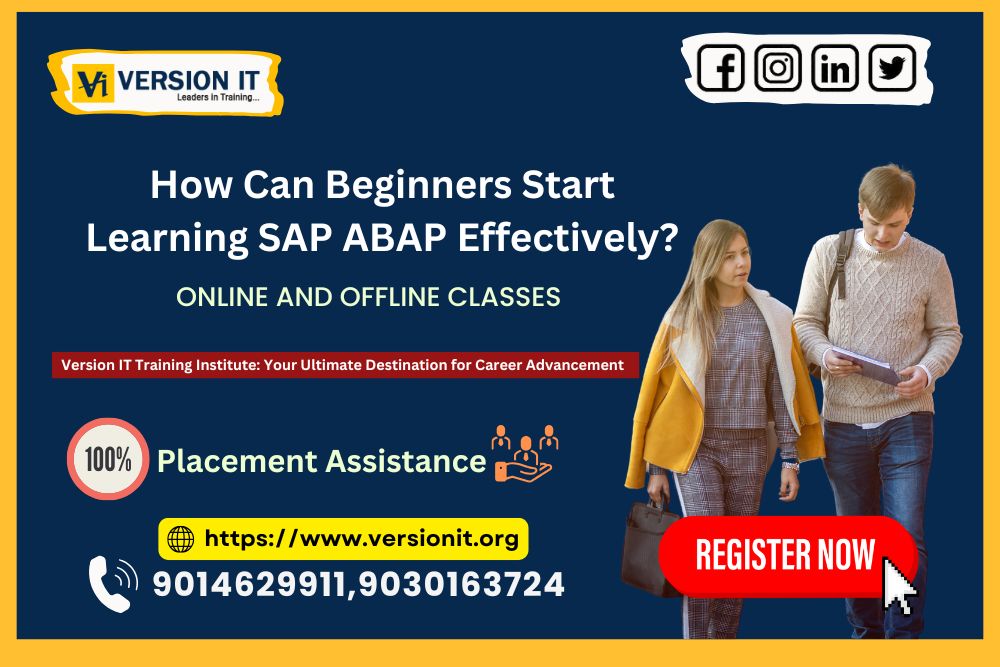SAP Advanced Business Application Programming (ABAP) is the backbone of SAP applications, enabling businesses to customize and enhance their ERP systems. As a beginner, diving into SAP ABAP might seem daunting, but with a structured approach, mastering this programming language becomes an achievable goal. Here’s a comprehensive guide to help beginners start learning SAP ABAP effectively.
- Understand the Basics of SAP and ABAP
Before diving into coding, it’s essential to understand what SAP is and how ABAP fits into the SAP ecosystem. SAP is an enterprise resource planning (ERP) software that integrates various business functions like finance, procurement, and sales. ABAP is a high-level programming language used to develop applications within the SAP environment. Beginners should start by learning:
- The role of SAP in enterprise solutions
- The basics of ERP and how businesses use SAP
- The purpose and structure of ABAP in SAP
- Set Up a Learning Environment
To practice ABAP coding, setting up a learning environment is crucial. Beginners can follow these steps:
- Access SAP GUI: The SAP Graphical User Interface (SAP GUI) is necessary for working with ABAP.
- Use SAP Trial Versions: SAP provides trial versions that allow beginners to practice ABAP coding.
- Join SAP Learning Hub: This platform offers extensive resources, tutorials, and sandbox environments for hands-on practice.
- Learn ABAP Syntax and Programming Concepts
ABAP programming requires a strong foundation in syntax and fundamental concepts. Beginners should start with:
- Data types and variables: Learn about different data types like integers, strings, and tables.
- Control structures: Understand loops, conditional statements, and case structures.
- Modularization techniques: Explore function modules, subroutines, and classes.
- Internal tables and database tables: Grasp how data is stored and manipulated in ABAP.
- Explore SAP ABAP Development Tools
SAP provides various tools to assist in ABAP development. Some essential tools include:
- ABAP Editor (SE38): Used for writing and executing ABAP programs.
- Function Builder (SE37): Helps create and manage function modules.
- Class Builder (SE24): Enables object-oriented programming in ABAP.
- Data Dictionary (SE11): Allows users to define and manage database tables.
- Debugging Tools: Help in identifying and fixing errors in ABAP programs.
- Work on Sample Projects and Hands-On Practice
Hands-on practice is crucial for mastering ABAP. Beginners can:
- Write simple ABAP programs to understand syntax and logic.
- Develop small projects like report generation and data manipulation.
- Explore real-world SAP scenarios to implement ABAP solutions.
- Participate in SAP communities and forums to learn from experts.
Enrolling in SAP ABAP Training in Hyderabad can provide structured learning, expert guidance, and hands-on experience to reinforce these concepts effectively.
- Understand Object-Oriented ABAP (OOABAP)
Modern SAP implementations rely on object-oriented programming (OOP) in ABAP. Beginners should learn:
- The fundamentals of OOP, including classes, objects, and inheritance.
- How to implement polymorphism and encapsulation in ABAP.
- The benefits of OOABAP in SAP application development.
- Learn Advanced ABAP Concepts
After mastering the basics, beginners should explore advanced ABAP topics such as:
- ABAP ALV (ABAP List Viewer): For creating interactive reports.
- BAPIs (Business Application Programming Interfaces): Used for integrating SAP applications.
- Enhancements and User Exits: Customization techniques for modifying SAP standard functionalities.
- SAP Fiori and CDS Views: Enhancing ABAP skills with modern UI and data modeling techniques.
- Stay Updated with Latest SAP Trends
SAP continuously evolves, and keeping up with trends is essential. Beginners should:
- Follow SAP blogs and forums.
- Enroll in SAP webinars and online courses.
- Stay informed about the latest SAP S/4HANA advancements.
- Seek Professional Training and Certification
Self-learning is beneficial, but professional training accelerates the learning process. Enrolling in Version IT ensures:
- Expert-led classes with real-world scenarios.
- Hands-on projects and live training sessions.
- Certification guidance to enhance career prospects.
Conclusion
Learning SAP ABAP effectively requires a structured approach, hands-on practice, and continuous learning. By understanding SAP fundamentals, setting up a learning environment, exploring development tools, and working on real projects, beginners can master ABAP efficiently. Professional training and certification further enhance skills and career opportunities in the SAP ecosystem. With dedication and the right resources, anyone can become proficient in SAP ABAP and build a successful career in SAP development.




